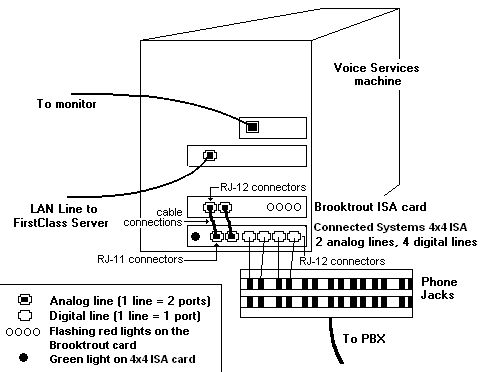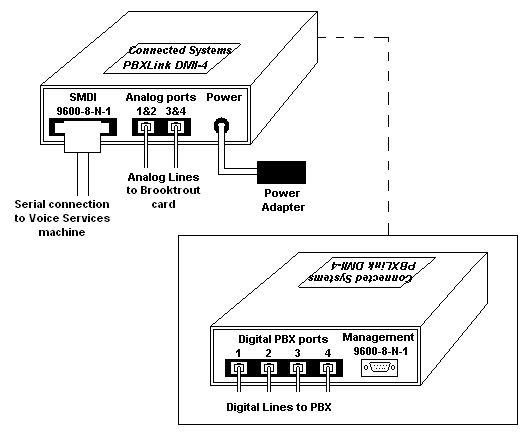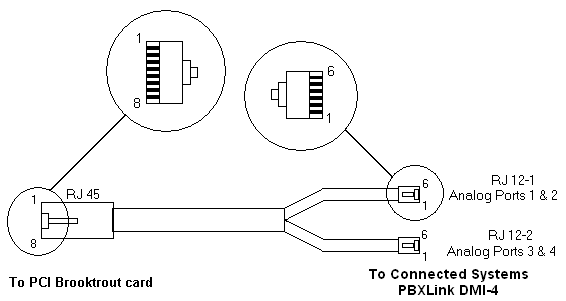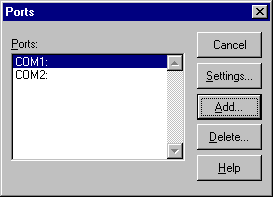| |
|
Basic hardware configurations
The basic hardware required to run Voice Services is a Connected Systems PBXLink and one or more Brooktrout TR114 4L ISA or PCI cards. This booklet explains how to install these cards, and configure them to be used with a Lucent Definity PBX. Throughout the installation process, you should keep track of all settings on a worksheet modelled on the one found at the end of this booklet.
Brooktrout card
The Brooktrout card connects 4 analog phone lines to the PBX. These are the lines the actual call is transferred to in order to be processed by Voice Services. Only the pilot number is ever dialed directly (this is how users log in).
Each Brooktrout card has 4 blinking red lights (corresponding to the 4 lines). When a port is busy, the corresponding red light will be lit solidly for the duration of the call. When the caller hangs up, the light will begin to blink again. If there are no lights lit on the card, the card or the lines may be malfunctioning or the machine may have lost power.
The more Brooktrout cards you have (more users, more lines), the more available slots you will require on the Voice Services machine. For information on the number of ports required for your system, see the recommendations here.
Connected Systems PBXLink
All references to Connected Systems PBXLink in this booklet pertain to the Connected Systems PBXLink ISA 4x4, the Connected Systems PBXLink DMI-4, and the Connected Systems PBXLink DMI-4 Plus. If only one version of the Connected Systems PBXLink is being referred to, the full name will be used.
There are five types of Connected Systems PBXLinks that can be used with Voice Services, three of which can be used with a Mitel SX-50, SX-200, or SX-2000 PBX (see the table below):
PBXLink type Compatible PBX
PBXLink Lucent Definity
Nortel Meridian 1
PBXLink ISA Lucent Definity
Nortel Meridian 1
PBXLink ISA 4x4 Mitel SX-50, SX-200, SX-2000
Nortel Norstar
PBXLink DMI-4 Mitel SX-50
Nortel Norstar
PBXLink DMI-4 Plus Nortel Meridian 1
Mitel SX-200, SX-2000
Connected Systems PBXLink ISA 4x4
The Connected Systems PBXLink ISA 4x4 is an ISA card installed in a slot in the Voice Services machine. One card supports one four-port Brooktrout card. It connects to the PBX by digital lines (up to four) and to Voice Services by an RS-232 link. It then links to the Brooktrout card by one to two analog lines (one line supports up to 2 ports).
The following diagram is a representation of a Voice Services machine configured with 1 Brooktrout card (ISA version) and a Connected Systems PBXLink ISA 4x4:
Connected Systems PBXLink DMI-4 and DMI-4 Plus
The Connected Systems PBXLink DMI-4 and DMI-4 Plus are external boxes that provide the same function as the Connected Systems PBXLink ISA 4x4 card.
The DMI-4 supports the Mitel SX-50, while the DMI-4 Plus supports the Mitel SX-200 and SX-2000. To upgrade the Connected Systems PBXLink DMI-4 to a DMI-4 Plus, contact Connected Systems for the correct firmware upgrade to use with your system.
Since Voice Services uses SMDI integration, it is necessary to turn off inband tones. This is done via the serial port menus by choosing Advanced > Inband Tones and changing Suppress Tones to ON.
The DMI-4 and DMI-4 Plus work with both the ISA and PCI Brooktrout cards. If a Brooktrout ISA card is used, the cables that are shipped with the product are used to connect to the Brooktrout card, as illustrated below:
If a Brooktrout PCI card is used, you need a customized cable. Centrinity can supply this cable or one can be made following the diagram below:
Use the following connections:
RJ45 RJ12
Pin 1 Pin4 of RJ12-2
Pin 2 Pin 3 of RJ12-2
Pin 3 Pin 2 of RJ12=1
Pin4 Pin3 of RJ12-1
Pin 5 Pin 4 of RJ12-1
Pin 6 Pin 5 of RJ12-1
Pin 7 Pin 5 of RJ12-2
Pin 8 Pin 2 of RJ12-2
Configuring the PBX
Read the Connected Systems documentation and follow all the steps for preparing and programming your Mitel PBX. This may have to be completed by a technician from your phone system provider.
Note
The following section should be used as a supplement to the Connected Systems documentation, highlighting steps which are unique to Voice Services, or where special attention should be taken to ensure successful configuration.
Mitel may make references to a dialable number. This is the pilot number.
SX-50
On an SX-50, the PBXLink ISA 4x4 emulates four DNIC 420 sets. The following steps must be performed to program the Mitel SX-50:
1 Set up the voice ports as described in the Connected Systems documentation.
2 Build a hunt group.
The SX-50 can have up to six hunt groups, configured using commands 361 through 366 respectively. Select a hunt group, and then program it with the extensions of the four ports.
3 Configure users' phones as described in the Connected Systems documentation.
If subscribers have names programmed, these must include the extension number at the beginning of the name. For example, a user with the name FRED on extension 201 would become 201 FRED.
SX-200 or SX-2000
On an SX-200 or an SX-2000, the following steps must be performed:
1 Set up the class of service (COS).
It is recommended that you use different COS numbers for the voice ports and users' ports, since voice ports require access to some features that ordinary users do not.
2 Set up the voice ports.
Each of the voice ports should be set up with their prime line on key 1. This is the default setting.
Each of the voice ports should be set up with an outgoing-only line on key 12 (for MWI). This is not the default setting.
3 Set up a hunt group.
Mitel PBXs allow hunt groups to be Terminal or Circular. The hunt group used for the voice ports should be Terminal.
4 Set up MWI Feature Access Codes (FAC).
MWIs are set or cleared by dialing a Feature Access Code (FAC) followed by an extension number. The FAC must be programmed in the PBX and the PBXLink ISA 4x4.
Note that when the PBXLink ISA 4x4 is programmed with the FAC, it requires a 1 after the FAC to turn MWIs on, and a 2 after the FAC to turn them off. For example, if *4 is the FAC for MWIs, the PBXLink ISA 4x4 should be programmed to use *41 for MWIs On *42 for MWIs Off.
5 Set up users' extensions.
If forward-on-busy or forward-on-no-answer to prime is desired, then the appropriate COS options to enable forwarding must be enabled (see step 1) and it may be desirable to program Forward keys onto each user's phone.
See the Connected Systems documentation for detailed examples and diagrams.
Configuring the COM port in Windows NT
Once the Connected Systems PBXLink has been installed and the COM port selected for the card has been entered on your worksheet, configure the COM port in your Windows NT operating system on the Voice Services machine:
1 Open Ports from the Control Panel.
COM1 and COM2 may be preconfigured in your machine.
2 Click Add to add the COM port for the Connected Systems PBXLink.
3 Choose the COM port you configured for the Connected Systems PBXLink.
4 Set Base I/O Port Address to the number you entered on your worksheet.
5 Set the IRQ to the number you entered on your worksheet.
6 Click OK to return to the Ports dialog box.
7 Click Settings and choose the options shown on the screen below:
8 Click Advanced.
9 Ensure:
• the COM port is correct (from the worksheet as above).
• The Base I/O Port Address and Interrupt Request Line (IRQ) are set to Default.
• FIFO Enabled is selected.
10 Click OK and exit, saving all changes.
Configuring the Connected Systems PBXLink settings
Once the Connected Systems PBXLink has been connected, and the COM port has been configured in Windows NT, you have to configure the internal settings for your Connected Systems PBXLink configuration.
Create a HyperTerminal file
Create a HyperTerminal file on the Voice Services machine to initialize the Connected Systems PBXLink.
1 Choose Programs > Accessories > Hyperterminal > HyperTerminal from the Start menu.
2 Enter Connected Systems PBXLink at Enter a name for the new connection.
3 Click OK.
4 Enter the COM port number configured for the Connected Systems PBXLink, configured in NT, and recorded on the worksheet at Connect using.
5 Click OK.
6 Type m and press Enter to access the Connected Systems PBXLink menu.
7 Stop the integration before changing any Connected Systems PBXLink settings:
• Press 1 for the Configuration menu.
• Press 1 to stop the integration.
8 Enter the following settings by following the steps in the Connected Systems documentation:
PBX Type
Do not choose a PBX type.
PBX Options
Prime # Enter the pilot number. If you ever change the pilot number, restart the Voice Services machine.
Number of lines licensed
Enter number of lines licensed (4, 8, 12, ... up to 24).
Connect using
COM# (where # is the COM port selected on the Connected Systems PBXLink)
Baud rate
9600
Data Bits
8
Parity
No
Stop Bits
1
9 Set the SMDI options.
Check CPID Length (option 2). This is the local dialing number length. If you live in an area where all local calls are 10 digits, ensure CPID Length is set to 10.
10 Restart the integration.
11 Type q and press Enter to exit.
12 Restart the Voice Services machine.
Troubleshooting the Connected Systems PBXLink
When the computer restarts, check the green light on the Connected Systems PBXLink:
The light is on steady
The connection was successful.
The light is on but blinks off briefly every 2 seconds
The digital line is working correctly but the integration must be restarted.
The light is off
The Connected Systems PBXLink is in boot-loader state or is not working correctly. See the Calista documentation.
The light is flashing slowly
The digital line is active but the PBX is not responding to the Connected Systems PBXLink.
The light is flashing quickly
No signal has been detected from the digital line. Check the physical connections and then check the line.
Installing the Brooktrout card(s)
Insert the Brooktrout card(s) into the slot(s) in the Voice Services machine as explained in the Brooktrout installation manual.
Install the Brooktrout software
1 Download the required Brooktrout software from the Voice Services CD.
There are three folders the Brooktrout driver requires:
• Install
• Kernel
• User.
2 Run Install.exe to install the Brooktrout driver.
3 Enter the number of lines you are installing (4 per card).
Configuring PCI Brooktrout card(s)
1 Enter the following information when prompted:
IRQ -1
DMA -1
Start faxinit on startup yes
Additional parameters required? no
2 Go to Faxinit.
Configuring ISA Brooktrout card(s)
Use defaults unless otherwise specified:
IRQ
5 (recommended)
Any available number between 1 and 10 can be used. For multi-card installations, use the same IRQ number for all cards. Remember to enter this number on the worksheet for future reference.
Set Base I/O address
For a one-card system, the base I/O address should be 260.
For a two-card system, the base I/O addresses should be 260 and 280.
For additional cards, see the chart in the Brooktrout manual.
Ensure the Base I/O address is entered on the worksheet.
DMA
1 (recommended)
Kernel buffer size
8092 (default)
Kernel IRZ size
10 (default)
Enable default?
No
Start driver automatically?
Yes (default)
Load faxinit on startup?
Yes
Additiional parameters file
Enter the full path to the address file.
Example: c:\winnt\bfax\address
Address file (ISA card only)
Create the address file:
1 Create a new text (ASCII) file using Notepad.
For a one-card system with a starting I/O of 260, the file will contain one line only:
addrs 264 4
For a two-card system with starting I/Os of 260 and 280, the file will contain two lines:
addrs 264 4
addrs 284 4
2 Save the file with the exact full path you specified above.
3 Open Windows Explorer and delete the .txt extension.
Faxinit
When installation is complete, ensure the following files are in your hard disk in the directory c:\winnt\bfax\:
• bfax.sys
• faxinit.exe
• runfaxin.exe.
After faxinit.exe runs, a log file will be created called faxinit.log. Details about faxinit.log are described in Verify hardware install.
At this point, there should be no lights lit on the Brooktrout cards. Once Voice Services has started and the software configurations have been set by following instructions in the administrator's online help, the lights on the Brooktrout cards should flash randomly.
|




